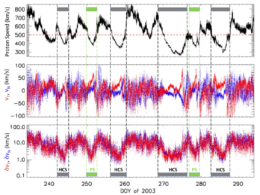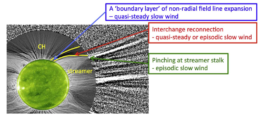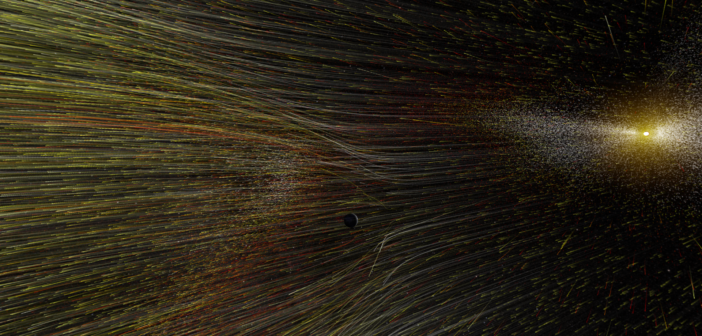The solar wind extends outward from the solar corona, suffusing interplanetary space with plasma and magnetic fields. While the solar wind has traditionally been designated as either “fast” or “slow” based on its velocity, a new study suggests that there may be a better way to characterize this highly variable plasma flow.

Coronal holes, like the one clearly visible as a dark region in this X-ray image of the Sun from Solar Dynamics Observatory, are thought to be the source of the fast solar wind. [NASA/AIA]
Slow vs. Fast
The fast solar wind is thought to originate from coronal holes — regions of open solar magnetic field lines. The slow solar wind has been associated with streams of coronal plasma emitted from near the Sun’s equator, but this source location for the slow solar wind is still up for debate.
The formation mechanism for the slow solar wind is also uncertain; one of the persistent questions of solar physics is whether the slow and fast solar wind form in fundamentally different ways.
Solving the mysteries of where and how the slow solar wind forms may rely on first finding a better definition of what constitutes the slow and fast solar wind. While regions of slow and fast solar wind have traditionally been separated based only on velocity, the parameters of the solar wind — such as the density, temperature, and ionization state — vary broadly for a given solar wind speed.

Comparison of solar wind proton speed, components of the proton velocity, and standard deviation in the components of the proton velocity. HCS and PS mark the times of heliospheric current sheet and pseudostreamer crossings, respectively. Low proton speeds are associated with low fluctuations in the proton velocity, while high speeds are associated with high fluctuations in the proton velocity. Click to enlarge. [Ko, Roberts & Lepri 2018]
An ACE up Their Sleeve
Yuan-Kuen Ko of the Naval Research Laboratory and collaborators argue that there is a better way to distinguish between the different states of the solar wind.
By analyzing data from NASA’s Advanced Composition Explorer (ACE), a solar and space exploration mission launched more than two decades ago, Ko and collaborators found that the slow and fast solar wind may be better distinguished by the magnitude of their velocity fluctuations rather than their absolute velocities. To demonstrate this, the authors compared the velocity fluctuation, δvT, to other observed solar wind properties. With the exception of the plasma beta — the ratio of the thermal pressure to the magnetic pressure — δvT correlates well with all observed solar wind properties.
Ko and collaborators also explored the effect the phase of the solar cycle has on solar wind parameters by comparing data from two time intervals: one from the period during which solar activity is declining, and one near solar minimum. The authors found that while the absolute values of the solar wind parameters during epochs of low δvT varied between the two phases, their overall behavior did not; parameters that increased with increasing δvT did so during both the declining phase of the solar cycle and solar minimum.

The three slow-solar-wind formation scenarios implied by the results. Click to enlarge. [Ko, Roberts & Lepri 2018]
More Solar Data Headed Our Way
What does this mean for the formation of the slow solar wind? Ko and collaborators derive three potential slow-solar-wind formation scenarios from their findings, none of which are mutually exclusive.
Distinguishing between these scenarios will have to wait — but not for long. Luckily, the next decade brings two highly anticipated spacecraft that will increase our understanding of the solar corona and solar wind, including the formation of the slow solar wind: NASA’s Parker Solar Probe, which started its journey to the Sun in August 2018, and ESA’s Solar Orbiter, which is scheduled to launch in February 2020.
Citation
“Boundary of the Slow Solar Wind,” Yuan-Kuen Ko, D. Aaron Roberts, and Susan T. Lepri 2018 ApJ 864 139. doi:10.3847/1538-4357/aad69e


5 Comments
Pingback: AAS Nova – New
Pingback: October 13 – October 19, 2018 | Colorado Space News
Pingback: October 13 – October 19, 2018 | SPACE FORCE
Pingback: October 13 – October 19, 2018 - MillionaireBiz
Pingback: October 13 – October 19, 2018 - monsterbizx